Abstract
Background:Spondylolysis and Spondylolisthesis are common spinal conditions that can result in significant morbidity, including chronic back pain, reduced physical function and impaired quality of life. There is lack of data on the prevelance of such conditions in Kuwait, creating a gap in knowledge that my hinder effective health care planning and interventions. Early diagnosis and management are crucial to prevent progression and complications such as neurological deficits. This study aims evaluate the prevelance of spondylolysis and spondylolisthesis and their characteristics in two tertiary care centers in Kuwait to provide baseline data for future research and clinical practice.
Methods:This cross-sectional, observational study included patients seen at specialized spine clinic in two tertiary centers in Kuwait. Participants were included if a previous diagnosis of spondylolysis or spondylolisthesis was re-confirmed with radiological evaluation, with at least >5% vertebral slippage.
Results:The prevalence of spondylolisthesis was 6.1% in 1,000 patients screened. Thirty-three percent were male, and the mean age was 55 years (range: 16.0-80.0). Degenerative spondylolisthesis was the most common type identified (60%) with L5-S1 vertebral level being the most common the most common level involved (56%). Most of the patients (74%) had grade 1, 18% had grade 2, and 8% had grade ≥ 3 spondylolisthesis.
Conclusion:The prevalence, type, level, and grade of Spondylolisthesis in our population were consistent with those of previous studies conducted in this area of knowledge.
Keywords:Prevalence; Spondylolisthesis; Spondylolysis; Back Pain; Spinal Deformity
Introduction
Spondylolysis and spondylolisthesis are relatively common conditions with varying prevalence depending on the population studied. Their clinical significance is primarily related to their potential to cause low back pain and other neurological [1]. However, these conditions can be present asymptomatically through incidental radiological investigations. Spondylolysis can be defined as an anatomical defect or stress fracture of the pars interarticularis that affects vertebral and facet joints. Spondylolisthesis is the displacement of the vertebrae subjacent to it [1]. Although there has been agreement regarding the natural history of the disorder, the associated risk factors regarding prevalence are controversial. In previous studies of Spondylolysis and Spondylolisthesis, there has been a solid acknowledgment of predisposing risk factors such as sex, age, and lower back pain, which are deemed conclusive in various evaluations [2]. This study aimed to observe the trends of spondylolisthesis in the Kuwaiti population and its correlation with lower back pain, and chronic illness (Table 1).
Subjects and Methods
A cross-sectional, observational study was conducted in 2016 in two major tertiary hospitals in Kuwait (Al Razi orthopedic Hospital and Shaikhan Al Farsi Rheumatology Center). This patient population is composed of patients who present to a specialized spine clinic for consultation/treatment regardless of their condition regarding the entire spine were included. Patients that had been previously diagnosed with spondylolysis and spondylolisthesis were further examined to re-confirm the diagnosis. Additional investigations such as radiographs (anterior/posterior and lateral X-rays) were used to determine the level and grade of this disorder with the anticipation of linking any correlation between radiological findings and clinical symptoms based on history and examination. In addition, a checklist was employed to correlate any associated risk factors with this disorder, which was based on a report from the Ministry of Health in Kuwait with the support of the World Health Organization (WHO) concerning the risk factors of non-communicable diseases within this region.
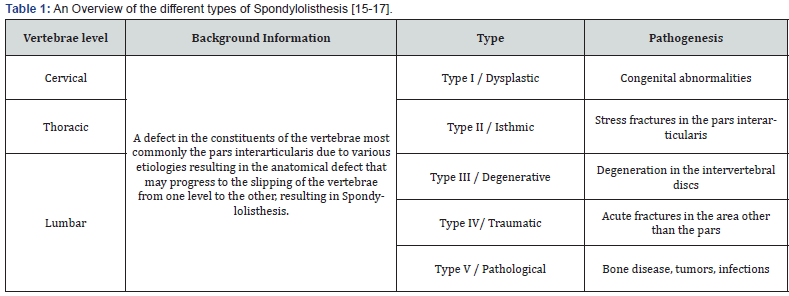
The patients included in this study were diagnosed with spondylolisthesis. These patients were reinvestigated from a radiological point of view (standing radiography) to confirm previously diagnosed cases. The exclusion criteria for this study were patients who were previously diagnosed with spondylolisthesis but had insufficient radiological evidence in addition to a vertebral slip of <5%. The patients included in this study had the following parameters: chief complaint of lower back pain, age, sex, level of spondylolisthesis, type and grade of spondylolisthesis, occupation, past medical history, and social history that included nutrition and exercise. Random sampling was used to stratify our population. There were specified days in the week that were designated for accepting patients to these clinics notwithstanding the type of condition that they may present with.
Results
The patient population that was under investigation, which resulted in a total of 1,000, included 61 cases with a mean age of ∼55 years (54.7) that were identified with spondylolisthesis. With a confidence interval of 95% (0.119), the prevalence of spondylolisthesis was 6.1% (±0.119) of the true value. In addition, the Male to Female ratio that has been reported in the study is 20:41 i.e. (1:2). Females are twice as likely to have this disorder than males. The highest frequency of spondylolisthesis was degenerative spondylolisthesis (66%), followed by isthmic spondylolisthesis (30%), and dysoplastic spondylolisthesis (5%) (Figure 3). The vertebral level L5-S1 was the most common level involved (56%) with L4-L5 level involved in 37% (Figure 4) in comparison to most studies concerning spondylolisthesis [2-4] (Figures 1 & 2). Lower back pain was reported in 92% of those with spondylolisthesis, with a confidence interval of 95% (1.679%) and ~92% (91.80%) ± 1.679% from the true interval). Unfortunately, there is inconclusive evidence of a correlation between spondylolisthesis and occupation. The prevalence ratio was not calculated, as there were insufficient data. The study’s main aim was to not only determine the prevalence and link lower back pain to this disorder but also to identify any other associated risk factors that might have an impact on this disorder. There seems to be no exact or definite indication for a single disease/ disorder that may be considered a factor that might result in the development of spondylolisthesis. However, (CI 95%) 13 out of 61 (21 ± 2.11%) patients with spondylolisthesis also had a history of hypertension, (CI 95%) 16 out of 61 (26.23% ± 1.95%) patients with spondylolisthesis who had a history of Diabetes Mellitus, and (CI 95%) 7 of the 61 (11.475 ± 2.27%) patients had hypothyroidism, but the question is, are these chronic illnesses the reason for the increased risk of this disorder? Because of the nature of these systemic illnesses, they can affect the prognosis of this disorder; however, are critical risk factors that have a distinct effect on this specific disorder. Simply put, there is little evidence to support this theory. Regarding the patients’ lifestyle, since Kuwaiti population is one of the top ten ranked countries in regards to obesity and being overweight, most patients that were studied are not exercising as an average individual, which is 150 min of aerobic exercise per week. The majority of patients lived a sedentary lifestyle in addition to a poor nutritional diet.
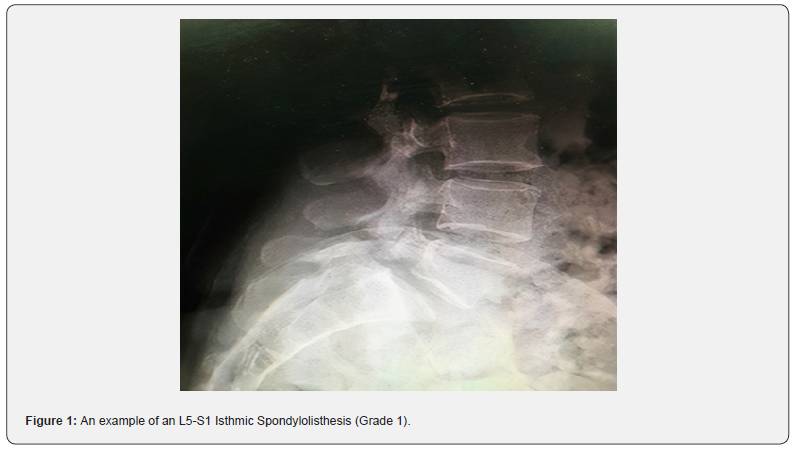
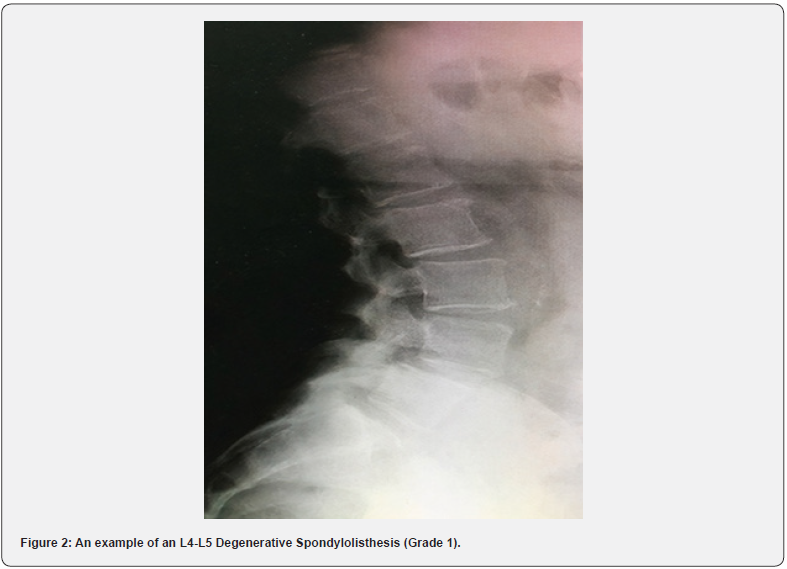
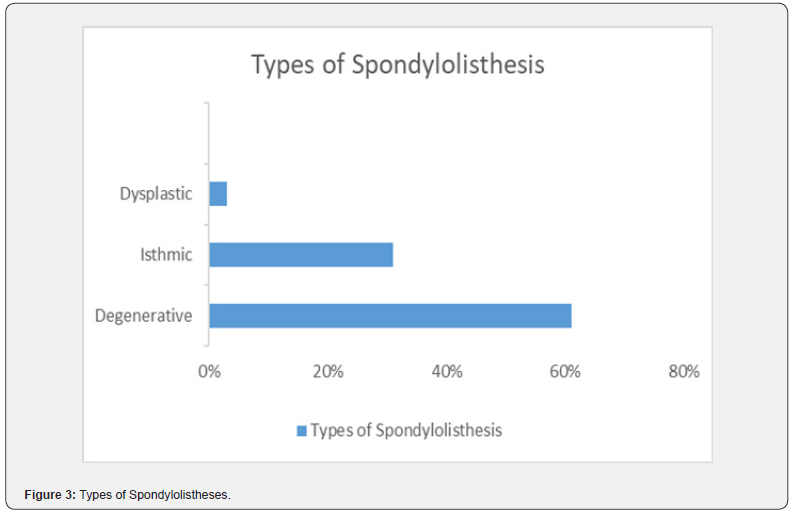
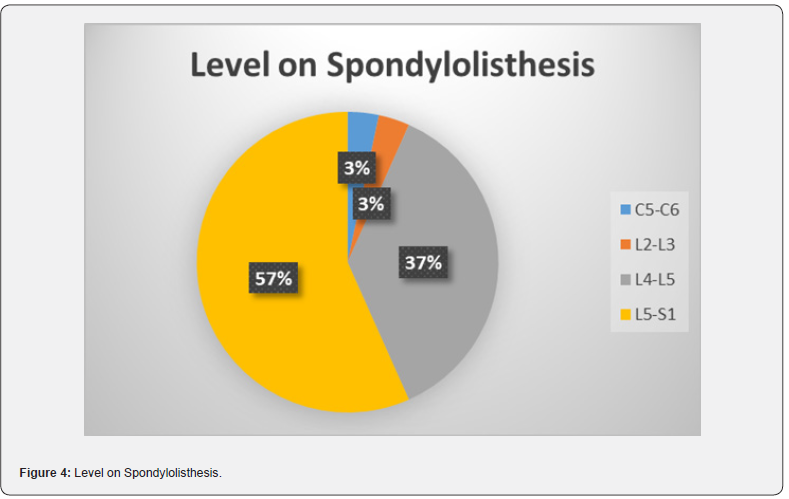
Discussion
Looking at this study, in contrast to other conventional research findings, some similarities and differences were evident. This study had consistent factors and results that have been established in previous studies. The conventional prevalence (6-8%) [5-7]. Gender preference (i.e. females) is more likely to have this disorder [8,9]. The type of spondylolisthesis, that is, degenerative and level of vertebral involvement, L5-S1. However, there were variances established within this study, in contrast to other generalized studies. The fact that the population was a patient population was an attempt to link any causative or associative risk factors to this condition. In addition, the correlation between symptoms such as lower back pain and radiological findings [3,10] was shown to have a synergistic effect in this study.
Various aspects were considered when developing the methodology. The inclusion criteria played a significant role in differentiating this study from others. An effort was made to incorporate all types of spondylolisthesis, and not restricting the age limit, to obtain an overview of the actual prevalence of spondylolisthesis. In addition, other factors in the methodology that were considered were the use of standing radiographs as a means to confirm the diagnosis in comparison to MRI or CT scans. The reasoning behind this was that radiographs (anterior/ posterior and lateral X-rays) were more sensitive in the ability to pick up a grade 1 spondylolisthesis (Meyerding classification of 0-25%) [11] versus other modalities of investigations that required the patient to lie down, limiting the opportunity to establish a proper diagnosis.
To comply with the epidemiological standards of accuracy and precision, stratified random sampling was used to establish a representative sample. Randomization through a patient population was obtained through the inclusion of cases on the day of data collection (prospectively) with the purpose that the physician was not aware of the patients presenting to the clinic. Stratification was entrenched by having a fixed day in the week with a set number of patients who presented to the clinic.
Certain considerations need to be considered, as this result included all types of spondylolistheses. Factors contributing to its low value were the incorporation of dysplastic spondylolisthesis (due to congenital defects) and isthmic spondylolisthesis (having various etiologies due to sports injury or trauma). The implications of this study should be a reference when looking at spondylolisthesis in the Middle East, especially in Kuwait. Although this investigation seems to have a broad indication of what the disease itself is and factors that play a role, it has incorporated various risk factors derived from noncommunicable diseases (NCD) such as cardiovascular diseases, diabetes, hypertension, and several generalized chronic illnesses that burden the individuals’ health population [12]. The setback faced in this study was the lack of evidence correlating occupation with spondylolisthesis. There was a spectrum of responses ranging from unemployed individuals, housewives, individuals who worked in the government sector, retired individuals with unknown occupations, teachers, and officers. Recommendations for further research regarding the correlation of degenerative spondylolisthesis with Body Mass Index (BMI) or occupation would show a strong relationship [13], which highlighted a correlation between degenerative spondylolisthesis and the “wear and tear” ideology [14].
Conclusion
A prevalence rate of 6% within the Kuwait Patient Population, in addition to the predominance of the type of spondylolisthesis (degenerative) and the level of vertebral involvement (L5-S1) is an indication that the study’s findings are consistent with those of previous studies concerning the prevalence of spondylolisthesis. The fact that there is a correlation between Lower Back Pain and the diagnosis of Spondylolisthesis illustrates that Lower Back Pain is a contributor to the diagnosis of this condition.
Conflict of Interest
None of the authors has any conflict of interest to declare.
“AA certifies that he or she has no financial conflict of interest
(eg, consultancies, stock ownership, equity interest, patent/
licensing arrangements, etc) in connection with this article.”
“AS certifies that he or she has no financial conflict of interest
(eg, consultancies, stock ownership, equity interest, patent/
licensing arrangements, etc) in connection with this article.”
“YA certifies that he or she has no financial conflict of interest
(e.g., consultancies, stock ownership, equity interest, patent/
licensing arrangements) in connection with this article.”
“ER certifies that he or she has no financial conflict of interest
(e.g., consultancies, stock ownership, equity interest, patent/
licensing arrangements) in connection with this article.”
References
- Herring SA, Standaert CJ (2000) Spondylolysis: a critical review. Br J Sports Med 34(6): 415-422.
- Devine JG, Schenk-kisser JM, Skelly AC (2012) Risk factors for degenerative spondylolisthesis: a systematic review. Evidence-Based Spine-Care Journal 3(2): 25-34.
- Raastad J, Reiman M, Coeytaux R, Ledbetter L, Goode A (2014) The association between lumbar spine radiographic features and low back pain: a systematic review and meta-analysis: United States: American College of Rheumatology Annual Conference Boston; Ma. 44(5): 571-585.
- Farfan HF, Osteris V, Lamy C (1976) The mechanical etiology of spondylolysis and spondylolisthesis. Clin Orthop 117: 40–55.
- Jacobsen S, Sonne-Holm S, Rovsing H, et al. (2007) Degenerative lumbar spondylolisthe- sis: an epidemiological perspective: The Co- penhagen Osteoarthritis Study. Spine (Phila Pa 1976) 32(1): 120-125.
- Denard PJ, Holton KF, Miller J, Fink HA, Kado DM (2010) Lumbar spondylolisthesis among elderly men: prevalence, correlates and progression. J Babol Univ Med Sci 35(10): 1072-1078.
- Chen JC, Chan WP, Katz JN, W P Chang, D C Christiani (2004) Occupational and personal factors associated with acquired lumbar spondylolisthesis of urban taxi drivers. Occup Environ Med 61(12): 992-998.
- Love TW, Fagan AB, Fraser RD (1999) Degenerative spondylolisthesis: developmental or acquired? J Bone Joint Surg Br 81(4): 670-674.
- Rosenberg NJ (1975) Degenerative spondylolisthesis. Predisposing factors. J Bone Joint Surg Am 57(4): 467-474.
- Libson E, Bloom RA, Dinari G (1982) Symptomatic and asympto- matic spondylolysis and spondylolisthesis in young adults. International Orthopaedics 6(4): 259-261.
- Gaillard F (2016) Spondylolisthesis grading system. Radiology Reference Article
- Al -Nesf Y, Kamel l, Makboul M, El-Sayed A, El-Shazly M, et al. (2009) Risk Factors of Non-Communicable Disease in the State of Kuwait. Kuwait: Ministry of Health.
- Ministry of Health (2013) State of Kuwait World Health Survey in Kuwait; Main Report. Kuwait City: Ministry of Health.
- Virta L, Rönnemaa T, Osterman K, Aalto T, laakso M (1992) Prevalence of isthmic lumbar spondylolisthesis in middle-aged subjects from eastern and western Finland. J Clin Epidemiol 45(8): 917-922.
- Jacobsen S, Sonne-Holm S, Rovsing H, et al. (2007) Degenerative lumbar spondylolisthe- sis: an epidemiological perspective: The Co- penhagen Osteoarthritis Study. Spine (Phila Pa 1976) 32(1): 120-125.
- Woolfson T, Hughes SPF (2008) Synopsis of Causation, Spondylolisthesis (incorporating Spondylolysis and Spondyloptosis): United Kingdom: Ministry of Defense.
- Tsirikos AI, Garrido EG, Coeytaux R, Ledbetter L, Goode A (2010) Spondylolysis and spondylolisthesis in children and adolescents. BJJ 92(6): 751-759.






























